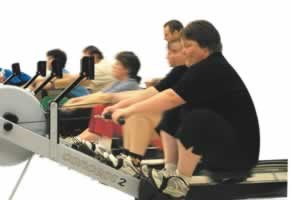BY
LAUREL MYERS
The world of athletic opportunity is being opened wider for
those who were previously limited in their ability to
participate, specifically in rowing.
With the help of adaptive equipment, individuals with physical
limitations are being offered an opportunity to compete
side-by-side with able-bodied rowers.
"Adaptive rowing is a relatively new sport in Canada,"
explained Thomas Merritt, a professor in the chemistry and
biochemistry department at Laurentian University. "It started
in Toronto in 2001 and has since spread out across Ontario."
Eager to jump on board with adaptive rowing, Merritt, along
with Minna Mettinen-Kekalainen - a top wheelchair rower who
competed for a spot on the Canadian National Adaptive Rowing
Team - started the Sudbury Rowing Club's Adaptive Program in
May 2007.
"We're giving people who generally don't have access to sports,
access to sports," Merritt said. "The idea of adaptive rowing
is we adapt the equipment to the athlete, not the athlete to
the equipment."
Since October, Merritt has been doing monthly, and more
recently bi-weekly, rowing machine sessions at Sudbury's
Independent Living Resource Centre. In about one month's time,
the rowing sessions will move to the water.
The Independent Living Resource Centre is the selected
beneficiary charity for this year's Dragon Boat Festival, and
for the first time, the Centre will be entering their own
Dragon Boat team. With the competition looming, members are
adamant about getting prepared for the grueling sprints and
frenzied rowing on race day.
"It's a lot of fun," said Cheryl Bruce, a first-time rower and
member of the Dragon Boat team. "I'm looking forward to getting
my body in better shape. So far, I think it's working."
She added, though this has been her first experience with
rowing, she was already starting to find the work on the
machines easier.
"I started at five minutes, then moved up to 10 and now I'm at
20," she said with a beaming smile.
For Brian Norton, 41, getting strapped into a rowing machine is
a way for him to explode with the upper body strength he has
developed over the years.
"I wanted to try rowing out and they (the coaches) saw how
strong I was from pumping my wheelchair," he said.
Like Bruce, this is Norton's first go at rowing, and though he
said he's a bit tippy getting into the boat, he can't wait for
the Dragon Boat races.
"It's going to be a good, stiff competition," he said, adding
he's already an athlete in the Special Olympics, competing in
bowling, swimming, curling and T-ball.
At the international level there are three categories for
adaptive rowing: arms only, for people with compromised trunk
mobility, trunk and arms, for amputees or people who are
compromised from the waist down, and full stroke.
Norton has limited use of his legs due to cerebral palsy. By
using a specially designed rowing seat with a belt across the
waist, he is able to use his chest and arms for power.
At a fundraiser held at Lockerby Composite School last weekend,
the rowers from the Independent Living Resource Centre were
invited to race with Lockerby's student rowing team on
stationary rowing machines.
Two students chose to strap themselves into the adaptive
equipment along side Norton and race with him. As one student
attested, taking his legs out of the picture made a huge
difference in his power.
"It's way harder," said Evan Gould, Grade 12. "I'm used to
getting most of my power from my legs."
Using the special equipment gave Gould a heightened
appreciation for the athletes with physical limitations.
"It' a lot harder for them," he admitted. "I have every muscle
in my body to help me."
Merritt explained the integration between the disabled and
able-bodied athletes was a huge perk to the adaptive rowing.
"The nice thing about adaptive rowing is that it's part of the
rowing program and we're integrating them in with the
able-bodied rowers," he said. "That's great for the disabled
rowers - it gets them out and working, and breaks the isolation
that can be part of a physical or mental disability.
"It's even better for able-bodied rowers," he added. "I mean,
how often do high school kids get a chance to work with people
with physical and mental disabilities on an even playing field.
Merritt has had a passion for rowing since he came across it in
university 20 years ago and is eager to share his passion with
others.
"It was a great way for me to discover sport - I was not
athletic, but when I started to row, I got hooked," he said.
"This is a great way for me to give back to rowing and bring a
group of people who don't get a chance to participate in
sports, into a sport that means a lot to me."
Join Sudbury.com+
- Messages
- Post a Listing
- Your Listings
- Your Profile
- Your Subscriptions
- Your Likes
- Your Business
- Support Local News
- Payment History
Sudbury.com+ members
Already a +member?
Not a +member?
Sign up for a Sudbury.com+ account for instant access to upcoming contests, local offers, auctions and so much more.
